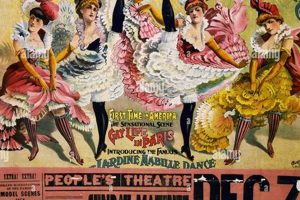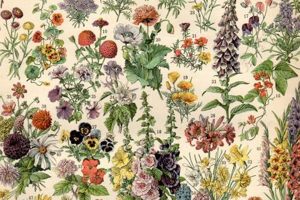Illustrations of plant life, rendered in a style characteristic of earlier eras and reproduced for decorative purposes, constitute a distinct category of artwork. These items frequently feature detailed depictions of flora, often accompanied by scientific nomenclature or artistic embellishments reflective of the period in which they were created. Examples include lithographs from the 19th century depicting medicinal herbs and colorful plates from early 20th-century seed catalogs.
The appeal of these decorative items lies in their capacity to evoke nostalgia and provide a connection to the natural world. They can serve as educational tools, showcasing botanical diversity and historical perspectives on scientific illustration. Moreover, their aesthetic qualities contribute to interior design schemes, introducing elements of organic beauty and historical significance to living spaces. The creation and dissemination of such images reflect evolving attitudes toward scientific understanding and artistic expression.
The following sections will delve into the specific techniques used in creating these images, the prominent artists and publishers involved in their production, and guidance on collecting and preserving them for future generations. It will also provide information on how to incorporate these pieces into contemporary design and decor.
Acquiring and Maintaining Botanical Art
The following guidelines offer assistance in the process of selecting, preserving, and presenting botanical illustrations produced in earlier eras. These suggestions are designed to ensure the longevity and aesthetic value of the artwork.
Tip 1: Authentication and Provenance: Prior to acquisition, research the artwork’s origin and history. Verify authenticity by examining watermarks, printing techniques, and signatures, comparing findings with established records.
Tip 2: Condition Assessment: Conduct a thorough assessment of the artwork’s physical state. Observe for signs of discoloration, foxing (small reddish-brown spots), tears, or insect damage. Consider the potential cost of restoration when evaluating the purchase.
Tip 3: Preservation Techniques: Employ archival-quality framing materials, including acid-free mats and UV-protective glass or acrylic, to prevent degradation from light exposure and environmental factors.
Tip 4: Optimal Display Environment: Avoid direct sunlight and excessive humidity when displaying botanical artwork. Maintain a stable temperature and humidity level to minimize the risk of damage.
Tip 5: Cleaning and Handling: When cleaning, use only approved archival methods, such as gentle dusting with a soft brush. Handle the artwork with clean, dry hands or cotton gloves to prevent the transfer of oils or contaminants.
Tip 6: Storage Considerations: If storing artwork, use acid-free tissue paper and store flat in a dark, dry environment. Avoid stacking items directly on top of each other.
Tip 7: Professional Restoration: For significant damage, consult with a qualified paper conservator. Attempting to repair delicate artwork without professional expertise can cause irreversible harm.
Implementing these strategies safeguards the integrity of botanical artwork, ensuring its enduring beauty and historical value.
Subsequent sections will explore the artistic and scientific significance of botanical illustration, providing further context for appreciation and preservation.
1. Illustrative Technique
Illustrative technique forms a fundamental component of vintage botanical posters and prints, exerting a direct influence on their aesthetic appeal, scientific utility, and historical significance. The choice of illustrative methodwhether meticulous stipple engraving, detailed lithography, or painterly chromolithographydictates the level of botanical accuracy achieved, the visual texture conveyed, and ultimately, the impact of the artwork. For instance, the detailed stipple engraving used in many 18th and 19th-century botanical atlases enabled precise rendering of plant morphology, facilitating identification and scientific study. Conversely, the vibrant chromolithography prevalent in late 19th and early 20th-century seed catalogs prioritized visual appeal to promote sales, often sacrificing some degree of botanical precision.
The illustrative technique also reflects the technological capabilities and artistic preferences of the era in which the artwork was created. Early woodcuts offered a rudimentary yet distinctive aesthetic, while the advent of photomechanical reproduction in the late 19th century enabled the mass production of highly detailed botanical illustrations. The selection of a particular technique was also influenced by the intended audience and purpose of the artwork. Scientific publications often favored accuracy and clarity, whereas decorative prints aimed for visual beauty and emotional resonance. For example, the Curtis’s Botanical Magazine, renowned for its detailed hand-colored engravings, catered to a scientifically informed audience, while commercial seed catalogs employed colorful lithographs to attract potential buyers.
In summary, illustrative technique is not merely a stylistic choice but a critical factor shaping the character, purpose, and value of vintage botanical posters and prints. Recognizing the specific techniques employed provides insight into the historical context of these images, the priorities of their creators, and their intended function, whether scientific, commercial, or purely decorative. Understanding illustrative technique assists in proper identification, evaluation, and preservation of these important visual records.
2. Botanical Accuracy
Botanical accuracy serves as a critical determinant of value, utility, and historical significance in vintage botanical posters and prints. The degree to which a rendering faithfully represents the morphological characteristics of a plant species directly impacts its scientific, educational, and artistic merit. The level of precision evident in these images provides insight into the artist’s skill, the available resources, and the prevailing scientific standards of the period in which they were created.
- Detailed Morphological Representation
The meticulous depiction of leaves, stems, flowers, and fruits, with correct proportions, venation patterns, and surface textures, constitutes a cornerstone of botanical accuracy. Early botanical illustrations, created for identification and medicinal purposes, prioritized the accurate representation of key diagnostic features. For example, accurate depictions of leaf shape, margin type, and arrangement were essential for differentiating between similar plant species. Deviations from accepted botanical standards of the time negatively impact the scientific value of the image.
- Accurate Color Rendition
The faithful representation of plant colors plays a crucial role in identification and aesthetic appreciation. Precise color matching, achieved through techniques like hand-coloring or chromolithography, enhances the realism and informational content of the image. The use of inaccurate or stylized colors reduces the image’s scientific value and may lead to misidentification. The evolution of color printing technologies directly influenced the capacity to achieve accurate color rendition in botanical prints.
- Taxonomic Nomenclature and Labeling
The inclusion of accurate taxonomic names and descriptive labels provides essential contextual information and enhances the image’s scientific utility. Correctly identified plant species, accompanied by their scientific names, enable accurate cataloging and referencing. Errors or omissions in taxonomic nomenclature compromise the image’s value as a scientific record. The standardization of taxonomic naming conventions in the 18th and 19th centuries influenced the precision of labeling practices.
- Consideration of Natural Variation
Acknowledging the range of natural variation within a plant species demonstrates a deeper understanding of botany and enhances the scientific rigor of the illustration. Representing different growth stages, variations in leaf morphology, or the effects of environmental factors provides a more complete and nuanced depiction. Ignoring natural variation in favor of an idealized or stereotypical representation reduces the image’s scientific accuracy. For instance, depicting different leaf shapes or flower colors from the same plant could display more complete botanical acuracy.
The emphasis on botanical accuracy, or its lack thereof, serves as a valuable lens through which to examine the historical context, artistic intentions, and scientific understanding reflected in vintage botanical posters and prints. Evaluating the degree to which these images adhere to accepted botanical standards of their time informs both their scientific and aesthetic valuation. A nuanced understanding of the interplay between botanical accuracy, artistic style, and printing technology enriches the appreciation and preservation of these historically significant visual records.
3. Aesthetic Style
The aesthetic style manifested in items significantly determines their appeal and cultural relevance. The artistic choices made during creation influence perception and emotional response, directly impacting the decorative and historical worth of each piece. Style encompasses elements such as composition, color palette, linework, and overall artistic execution, reflecting prevailing artistic trends and cultural sensibilities.
For example, the aesthetic style of botanical prints from the Victorian era often emphasized romanticism and idealized representations of nature. These prints typically feature soft, pastel color palettes, intricate linework, and a focus on the beauty and elegance of floral forms. These artistic choices contribute to their desirability as decorative items, reflecting the Victorian fascination with natural history and sentimental aesthetics. In contrast, botanical illustrations intended for scientific purposes may exhibit a more austere and functional aesthetic style, prioritizing clarity and accuracy over artistic embellishment. The impact of Art Nouveau with its flowing lines and organic shapes influenced late 19th and early 20th-century botanical works, seen in posters that advertise seed companies. These posters serve not only as informational tools but also as visual embodiments of the Art Nouveau movement, highlighting its influence on commercial art and design.
The recognition and appreciation of aesthetic style are crucial for collectors, historians, and enthusiasts. Understanding these stylistic nuances enables a deeper understanding of their historical context and artistic merit. Collectors can use knowledge of stylistic trends to identify rare or exceptional examples, while historians can analyze stylistic changes to trace the evolution of artistic expression. Ultimately, aesthetic style stands as an intrinsic component of the decorative items, profoundly shaping their perception, value, and enduring legacy.
4. Printing Methods
The techniques used to reproduce botanical illustrations profoundly shaped the appearance, availability, and enduring legacy of these images. Different methods resulted in varying degrees of detail, color fidelity, and production costs, directly influencing their accessibility and intended purpose.
- Woodcut and Wood Engraving
These early methods, involving carving an image into a wood block, produced bold, linear designs. While relatively inexpensive, woodcuts lacked fine detail, limiting botanical accuracy. Wood engraving, using the end grain of the wood, allowed for finer lines and greater detail. Examples include early herbals, where simplicity and reproducibility were prioritized. The durability of wood blocks enabled large print runs, making botanical knowledge accessible to a wider audience.
- Engraving and Etching
Engraving involved incising an image directly into a metal plate, while etching used acid to create the design. Both techniques allowed for finer detail than woodcuts, resulting in more accurate botanical depictions. Hand-coloring was often added to engravings and etchings to enhance their visual appeal. Renowned botanical publications like Curtis’s Botanical Magazine relied on these methods for their detailed illustrations. The intricate detail and artistic skill required elevated these prints to works of art, appealing to both scientists and collectors.
- Lithography and Chromolithography
Lithography, using a grease-based image on a stone or metal plate, enabled the reproduction of tonal variations and detailed drawings. Chromolithography, a color lithographic process, allowed for the mass production of vibrant, multi-colored prints. Seed catalogs and horticultural publications widely adopted chromolithography for its ability to realistically depict flowers and fruits. This printing revolution democratized access to botanical imagery, making colorful and informative prints affordable for the general public.
- Photomechanical Reproduction
Late 19th-century photomechanical processes, such as halftone and collotype, enabled the reproduction of photographs and detailed drawings with unprecedented accuracy. These methods facilitated the mass production of botanical illustrations in books, journals, and posters. The combination of photographic realism and efficient printing techniques made botanical knowledge more accessible and visually appealing than ever before. This allowed for the distribution of very accurate and visually compelling images to a much wider audience than ever before.
These diverse printing methods highlight the evolving relationship between art, science, and technology in the creation and dissemination of botanical imagery. The choice of printing technique significantly influenced the appearance, cost, and accessibility of botanical prints, shaping their role in both scientific research and popular culture. Examining the printing methods used provides valuable insights into the historical context and artistic merit of vintage botanical posters and prints.
5. Paper Quality
The composition and characteristics of paper stock significantly influence the longevity, appearance, and value of vintage botanical prints. Paper quality affects the degradation rate, the ability to withstand handling, and the overall aesthetic presentation of these delicate works. The fibers used, manufacturing processes employed, and presence of additives contribute to the paper’s inherent stability and resistance to environmental factors.
- Fiber Composition and Acidity
The type of fiber used in paper production directly impacts its long-term stability. Papers made from wood pulp often contain lignin, an acidic compound that causes yellowing, embrittlement, and eventual disintegration. Conversely, papers made from cotton or linen rags are naturally acid-free and exhibit superior archival qualities. Many 19th and early 20th-century botanical prints were produced on wood pulp paper, making them particularly susceptible to deterioration. Therefore, assessing fiber composition and acidity levels is essential for determining the preservation needs of vintage botanical prints. Acid migration from poor-quality mounting materials can also damage prints, highlighting the importance of using acid-free archival supplies.
- Weight and Thickness
The weight and thickness of paper influence its strength, durability, and ability to withstand handling. Thicker, heavier papers offer greater resistance to tearing, creasing, and physical damage. Delicate, lightweight papers are more vulnerable to wear and tear, requiring careful handling and specialized preservation techniques. The weight and thickness of paper also affect its ability to accept and retain printing inks and pigments. Thicker papers tend to exhibit richer color saturation and sharper image detail. Knowing the paper’s weight can inform appropriate mounting, framing, and storage strategies for vintage botanical prints.
- Surface Texture and Finish
The surface texture and finish of paper impact the visual appearance of printed images and affect the way light is reflected. Smooth, calendered papers produce sharper, more detailed prints, while textured papers can add depth and character to the image. The finish of the paper can also influence the way colors appear; glossy finishes enhance color vibrancy, while matte finishes create a more subdued and natural look. The choice of paper surface texture and finish was often dictated by the intended purpose and aesthetic style of the botanical print. For example, scientific illustrations often favored smooth, matte papers for clarity and detail, while decorative prints might utilize textured or glossy papers for visual appeal.
- Watermarks and Chain Lines
Watermarks and chain lines provide valuable clues about the origin, date, and quality of paper used in vintage botanical prints. Watermarks, created during the papermaking process, often indicate the manufacturer and type of paper. Chain lines, subtle patterns impressed into the paper during manufacturing, reveal the papermaking techniques employed. These features can help authenticate prints and provide insights into the historical context of their production. The presence of a recognizable watermark or chain line pattern can increase the value and collectibility of a vintage botanical print.
In summary, an awareness of paper quality is crucial for appreciating, preserving, and evaluating vintage botanical prints. Fiber composition, weight, surface texture, and the presence of watermarks all contribute to the paper’s inherent characteristics and long-term stability. By understanding these aspects of paper quality, collectors, historians, and enthusiasts can make informed decisions about the acquisition, care, and display of these valuable historical artifacts.
6. Provenance
The documented history of ownership and origin significantly influences the valuation, authentication, and scholarly interpretation of vintage botanical illustrations. Understanding a print’s provenance provides crucial context, connecting it to specific historical events, artistic movements, and individuals, thereby enhancing its significance and collectibility.
- Artist and Publisher Attribution
Establishing the identity of the artist and publisher constitutes a fundamental aspect of provenance research. Accurate attribution validates the artwork’s authenticity and situates it within a specific artistic and commercial context. For example, prints published by renowned botanical houses like Curtis in London or Redout in Paris command higher value due to their association with established expertise and artistic quality. Conversely, unattributed prints require meticulous examination to determine their origins, impacting their perceived value and historical relevance.
- Historical Ownership and Collections
Tracing the ownership history of a botanical illustration reveals its journey through time and its association with notable collectors, institutions, or historical events. Prints originating from prestigious collections, such as those of prominent botanists, aristocratic families, or significant libraries, often possess enhanced value and historical interest. For instance, a print bearing the bookplate of a well-known botanist provides evidence of its scientific use and adds to its provenance. Documentation of past ownership strengthens authentication and contextualizes the artwork within a broader historical narrative.
- Exhibition and Publication Records
Documenting the exhibition and publication history of a print contributes to its provenance by demonstrating its visibility and recognition within the artistic and scientific communities. Prints featured in significant exhibitions or reproduced in influential publications gain enhanced credibility and historical importance. For example, a print displayed at a major botanical exhibition or illustrated in a seminal botanical text solidifies its position within the historical record. Exhibition and publication records provide concrete evidence of the print’s reception and impact.
- Dealer and Auction Records
Dealer and auction records, including catalogs, invoices, and sales receipts, offer valuable insights into a print’s market history and past valuations. These records establish a verifiable chain of ownership and provide evidence of the print’s trading history. Prints with a well-documented sales history command greater confidence in the market and are often considered more desirable by collectors. Auction records can also reveal trends in pricing and demand, influencing current market valuations and perceptions of collectibility. Clear documentation demonstrates the print’s progression through the art market.
In conclusion, provenance research serves as a cornerstone for understanding the complete story of a vintage botanical print, from its creation and distribution to its subsequent ownership and recognition. By meticulously tracing the artwork’s history, researchers and collectors can unlock valuable insights into its artistic, scientific, and historical significance, thereby enriching its appreciation and ensuring its preservation for future generations. Establishing a detailed provenance strengthens authentication and provides context for a deeper appreciation of the item.
Frequently Asked Questions
The following addresses common inquiries concerning vintage botanical posters and prints, providing factual information to clarify key aspects of their identification, valuation, and preservation.
Question 1: What distinguishes a “vintage” botanical print from a modern reproduction?
Authenticity resides in the printing technique, paper quality, and inherent signs of age. Modern reproductions typically employ offset printing on contemporary paper stock, while vintage prints often exhibit characteristics of earlier printing methods, such as lithography or engraving, on paper displaying a degree of age-related patina.
Question 2: How does one assess the condition of such items?
Condition evaluation necessitates careful inspection for discoloration, foxing (small reddish-brown spots), tears, water damage, or insect damage. The presence and severity of these flaws directly impact the artwork’s value and long-term preservation prospects.
Question 3: What factors contribute to the market value of old botanical prints?
Market value is influenced by several factors, including the rarity of the subject matter, the artist’s reputation, the quality of the printing technique, the condition of the print, and its provenance or documented history of ownership.
Question 4: What are the best practices for preserving old botanical illustrations?
Preservation strategies include archival-quality framing with acid-free mats and UV-protective glazing, storage in a stable environment with controlled temperature and humidity, and careful handling with clean hands or cotton gloves to prevent the transfer of oils and contaminants.
Question 5: Are there specific resources available for identifying these prints?
Identification can be aided by consulting specialized reference books on botanical illustration, online databases of botanical artists and publishers, and expert appraisers specializing in antique prints and drawings.
Question 6: How does the printing method influence its value and authenticity?
Printing methods serve as significant indicators of both value and authenticity. Hand-colored engravings or lithographs are often more valuable than mass-produced offset prints. Knowledge of historical printing techniques is essential for identifying forgeries and reproductions.
These answers provide fundamental insights into the world of vintage botanical illustrations. For more detailed information, consult specialized resources or experts in the field.
The subsequent section addresses strategies for integrating these pieces into contemporary design aesthetics.
Conclusion
The preceding examination of “vintage botanical posters prints” underscores the multifaceted nature of these items. Their value extends beyond mere decoration, encompassing scientific illustration, historical context, and artistic merit. Factors such as illustrative technique, botanical accuracy, aesthetic style, printing methods, paper quality, and provenance collectively determine their significance and market value. A comprehensive understanding of these attributes is essential for collectors, historians, and anyone seeking to appreciate these artifacts.
The preservation and study of this visual legacy holds enduring importance. These illustrations offer a tangible connection to past scientific endeavors, artistic trends, and evolving perspectives on the natural world. Continued research and informed collecting practices will ensure that these relics of botanical art remain accessible and appreciated for generations to come. Further study is recommended to more deeply appreciate and protect these significant resources.







